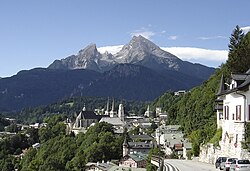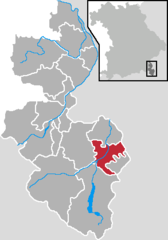Berchtesgaden(German pronunciation:[ˈbɛʁçtəsˌɡaːdn̩]) is amunicipalityin the districtBerchtesgadener Land,Bavaria,in southeasternGermany,near the border withAustria,30 km (19 mi) south ofSalzburgand 180 km (110 mi) southeast ofMunich.It lies in theBerchtesgaden Alps.South of the town, theBerchtesgaden National Parkstretches along three parallel valleys.
Berchtesgaden | |
|---|---|
 Berchtesgaden and theWatzmannin August 2010 | |
Location of Berchtesgaden within Berchtesgadener Land district  | |
| Coordinates:47°37′53″N13°0′15″E/ 47.63139°N 13.00417°E | |
| Country | Germany |
| State | Bavaria |
| Admin. region | Oberbayern |
| District | Berchtesgadener Land |
| Government | |
| •Mayor(2020–26) | Franz Rasp[1](CSU) |
| Area | |
• Total | 34.78 km2(13.43 sq mi) |
| Elevation | 700 m (2,300 ft) |
| Population (2023-12-31)[2] | |
• Total | 7,698 |
| • Density | 220/km2(570/sq mi) |
| Time zone | UTC+01:00(CET) |
| • Summer (DST) | UTC+02:00(CEST) |
| Postal codes | 83471 |
| Dialling codes | 08652 |
| Vehicle registration | BGL |
| Website | www |
TheKehlsteinmountain (1,835 m or 6,020 ft), with itsKehlsteinhaus(Eagle's Nest), is located in the area.
Etymology
editBerchtesgaden,Upper Bavaria (Achental), earlierPerchterscadmen,Perhtersgadem,Berchirchsgadem,Berchtoldesgadem;the word underwent a Latin distortion ofOld High Germanparach,Romancebareca'hay shed'. After the basic meaning was forgotten, a variant word of Old High Germangadem'room, one-room hut' was added, implying the same meaning: 'hay shed'. Cf. Old High Germanmuosgadem'spice room'.
There was afolk etymologythat supported a derivation based on the legendary figure ofFrauPerchta(Berchta), a woman (Holle<Holda'well disposed, dear') with good and bad changing features, who was venerated onPerchtertag(Epiphany) and was sworn to during the Perchta procession.[3]
History
editThis sectionneeds additional citations forverification.(July 2023) |
The first known record of the area, from 1102, mentions the area's richsalt deposits.Salt miningbegan in the area in 1517, and subsequently produced much of Berchtesgaden's wealth.[4]
The town and its surroundings belonged to theBerchtesgaden Provostry,an independent state of theHoly Roman Empire(calledFürstpropstei Berchtesgaden) and was ruled by thePrince-provostof theAugustinemonastery in the town. It remained independent until theReichsdeputationshauptschlussin 1803. During theNapoleonic wars,Berchtesgaden changed hands a few times, such as in 1805 under theTreaty of Pressburg,when the area was ceded to Austria.
Berchtesgaden came under the rule of theKingdom of Bavariain 1810. It soon became popular with the Bavarian royal family, theHouse of Wittelsbach,who often visitedKönigsseeand maintained a hunting residence in the former Augustine monastery (still used today byFranz, Duke of Bavaria). Tourism began to evolve and several artists came to the area, which reportedly gave rise toMalereck( "painters' corner" ) on the shore of the Königssee in nearbySchönau am Königssee.The most famous author who lived in Berchtesgaden wasLudwig Ganghofer.
Nazi era
editAdolf Hitlerbegan vacationing in the Berchtesgaden area in the 1920s. He purchased a home in theObersalzbergabove the town on the flank of theHoher Golland began extensive renovations on hisBerghofin the following years. As other topThird Reichfigures, such asHermann Göring,Joseph Goebbels,Martin Bormann,Heinrich Himmler,andAlbert Speer,began to frequent the area, the Nazi Party began to purchase and requisition land in the Obersalzberg.[5]
To serve as an outpost of the GermanReichskanzlei(Imperial Chancellery), Berchtesgaden and its environs (Stanggass) saw substantial expansion of offices, security, and support services, mainly on the Obersalzberg. Included in the town were anew railway station,with a reception area for Hitler and his guests, and an adjacent post office. The Berchtesgadener Hof Hotel, where famous visitors such asNeville ChamberlainandDavid Lloyd Georgestayed, was substantially upgraded.
Berchtesgaden was whereAdolf HitlermetNeville Chamberlainin 1938 before theMunich Agreement;seeBerchtesgaden meeting.
Even though a fearedAlpine Fortresslast stand of the Nazi Regime in the Alps failed to materialize late in World War II, the Allies launched a devastating air raid on the Berchtesgaden area in the spring of 1945. The 25 Aprilbombing of Obersalzbergdid little damage to the town. On 4 May, forward elements of the7th Infantry Regimentof the3rd Infantry Divisionarrived[6]and received the town's surrender.[7]
Post–World War II
editAfter the war, Berchtesgaden became a military zone and most of its buildings were requisitioned by theU.S. Army.Hotel Platterhof was rebuilt and renamed theGeneral Walker Hotelin 1952.[8]It served as aU.S. Armed Forces Recreation Centerthrough theCold Warand beyond.[9]Remnants of homes of former Nazi leaders were demolished in the early postwar years, though traces of some remained. In 1995, fifty years after the end of World War II and five years afterGerman reunification,the AFRC Berchtesgaden was turned over to Bavarian authorities to facilitate military spending reductions mandated within theBase Realignment and Closureprogram by the USCongressandPentagonduring the administration ofPresidentBill Clinton.[9]The General Walker Hotel was demolished in 2000–2001.
In 1986, Berchtesgaden was a first-round candidate city to host theXVI Olympic Winter Gamesto be held in 1992. The vote eventually went toAlbertville,France,in October of that year.[10]
Berchtesgaden today
editThe Hotel Türken, which was near the Nazi buildings and was often used by the SS and then by theGeneralmajorof the Police, was badly damaged in 1945. It was rebuilt in 1950 and reopened as a hotel before Christmas.[11]Visitors can still explore the historic underground hallways and tunnels that had been used by the Nazis.[12][13][14]
In 1972, local government reform united the then-independent municipalities of Salzberg, Maria Gern and Au (consisting of Oberau and Unterau) under the administration of the town of Berchtesgaden. Another suggested reform uniting all remaining five municipalities in the Berchtesgaden valley (Bischofswiesen, Ramsau,MarktschellenbergandSchönau) failed to gain enough popular support; it passed in Berchtesgaden but failed everywhere else.
The Berchtesgaden National Park was established in 1978 and has gradually become one of Berchtesgaden's largest draws. Mass tourism is confined to a few popular spots, leaving the rest to nature-seekers. Other tourist draws are theKönigssee,thesalt mine,theKehlsteinhaus,open seasonally as a restaurant, and theDokumentationszentrum Obersalzbergmuseum about the area's history, operated by the MunichInstitut für Zeitgeschichtesince 1999.[15][16][17]
Recreational and competitive sports have grown in importance. The town'sski slopeis popular. TheKönigssee bobsleigh, luge, and skeleton trackhas hosted ski-running and several international events and competitions. Berchtesgaden's most famous sports personality isGeorg Hackl,a multiple Olympic medal winner. The city is home to theInternational Luge Federation(FIL).
Unlike the northern part of Berchtesgadener Land and the Salzburg area, Berchtesgaden has virtually no manufacturing industry.
Berchtesgaden Central Stationis connected by theSalzburg–Berchtesgaden railwayto theRosenheim–Salzburg railwayatFreilassing.
The Bavarian state government facilitated the erection of a hotel, which opened in 2005 and is operated by theInterContinental Hotels Group.[16]Since May 2015, the hotel has been the Kempinski Berchtesgaden.[18][19]
Geography
editBerchtesgaden's neighbouring towns areBischofswiesen,Marktschellenberg,Ramsau,andSchönau am Königssee.
The municipality counts the following villages which are (Ortsteil): Am Etzerschlößl, Anzenbach, Hintergern, Metzenleiten, Mitterbach, Oberau, Obergern, Obersalzberg, Resten, Unterau, Untersalzberg I, Untersalzberg II, and Vordergern.
Notable people
edit- Wolfgang Bartels,(1940–2007), Olympicalpine skierbronze medalist
- Karl Bartos,(born 1952), electronic musician, former electronic percussionist in the bandKraftwerk
- Sigmund Freud,(1856–1939), psychoanalyst, owned a house for family holidays in Schönau near Obersalzberg. His villa was taken over during the Second World War by Heinrich Himmler.
- Franz Graßl,(born 1965),ski mountaineer
- Judith Graßl,(born 1968),ski mountaineer
- Georg Hackl,(born 1966), first Winter Olympics competitor to win five consecutive medals with consecutively two silver and three gold medals in the men's singlelugeevent
- Adolf Hitler,(1889–1945), leader of theNazi Partyand German dictator 1933–1945; owned theEagle's Nestmountain retreat in Berchtesgaden
- Kathrin Hölzl,alpine ski racerand gold medalist in thegiant slalomat the2009 World Championships
- Princess Irmingard of Bavaria,Naziresister and survivor ofOranienburg-Sachsenhausen,FlossenbürgandDachauconcentration camps
- Katrya Hrynevycheva,Ukrainian writer and community leader.
- Jutta Kleinschmidt,(born 1962), Germanoffroad automotive racingcompetitor
- Toni Kurz,(1913–1936), German 20th centurymountaineer
- Patric Leitner,five-time winner oflugeWorld Cup and four-time World Championship titles (in men's doubles withAlexander Resch)
- Felix Loch,four-timelugegold medalist (two in singles and two in mixed team)FIL World Luge Championships
- Manuel Machata(born 1984), German former bobsledder
- Peter Öttl,Grand Prixmotorcycleroad racer
- Hans Plenk,Olympic bronze-medalist in the men's singlelugeevent
- Romy Schneider,(1938–1982), German-French film actress
- Kaspar Stanggassinger,(1871-1899), Redemptorist priest, declared Blessed in 1988
- Silvia Treimer,ski mountaineer
- Hermann von Barth,(1845–1876), German 19th centurymountaineer
- John Allan Wyeth(1894–1981),Americanwar poetandPost-Impressionistpainter, was a regular visitor to Berchtesgaden, where he would indulge in his passion for landscape painting, during the 1930s.
Toy symphonies
editIn the 1760s several anonymous toy symphonies (including the famousToy Symphonyoften attributed toHaydnorLeopold Mozart) were composed at Berchtesgaden, then a manufacturing centre for toy instruments.[20]Some of the instruments used for these can be seen in theMuseum Carolino Augusteumin Salzburg.[21]
References
edit- ^Liste der ersten Bürgermeister/Oberbürgermeister in kreisangehörigen Gemeinden,Bayerisches Landesamt für Statistik,accessed 19 July 2021.
- ^Genesis Online-Datenbank des Bayerischen Landesamtes für Statistik Tabelle 12411-003r Fortschreibung des Bevölkerungsstandes: Gemeinden, Stichtag(Einwohnerzahlen auf Grundlage des Zensus 2011).
- ^Translated by Carl Masthay, St. Louis, 2012, from Wilhelm Sturmfels and Heinz Bischof:Unsere Ortsnamen im ABC erklärt nach Herkunft und Bedeutung,Bonn, 1961, Ferdinand Dümmlers Verlag.
- ^The Mysterious World of Salt– Salzbergwerk Museum tourist information leaflet.
- ^"History of the Obersalzberg, Hitler's Mountain".
- ^World War II: Race to Seize BerchtesgadenHistoryNet 12 June 2006
- ^UNITED STATES ARMY IN WORLD WAR II, Special Studies, CHRONOLOGY 1941–1945."In U.S. Seventh Army's XV Corps area, 101 regiment, croberg, Hitler's Mountain
- ^Walden, Geoffrey R."Platterhof".Third Reich in Ruins.Retrieved10 September2016.
- ^ab"U.S. to give back Hitler's resort".Eugene Register-Guard.Oregon. 5 February 1995. p. 16A.
- ^"Past Results".GamesBids. Archived fromthe originalon 4 May 2012.Retrieved11 December2018.
- ^"Hotel zum Turken - UPDATED 2018 Prices, Reviews & Photos (Berchtesgaden, Germany) - TripAdvisor".Tripadvisor.ca.Retrieved14 October2018.
- ^"Visit Hotel Zum Turken WWII Bunkers on your trip to Berchtesgaden".inspirock.Archived fromthe originalon 8 August 2017.Retrieved9 August2017.
- ^Wilson, James (13 January 2014).Hitler's Alpine Headquarters.Pen and Sword.ISBN9781473831872– via Google Books.
- ^Bunkersite."Hotel zum Türken, Obersalzberg - Bunkersite".bunkersite.
- ^"Dokumentation Obersalzberg: Home".Archived fromthe originalon 29 June 2017.Retrieved27 November2018.
- ^abRyback, Timothy W. (1 April 2005)."The Hitler Shrine".The Atlantic.
- ^"THE 15 BEST Things to Do in Berchtesgaden 2018 - Must See Attractions in Berchtesgaden, Germany | TripAdvisor".Tripadvisor.ca. 28 November 2017.Retrieved14 October2018.
- ^"Luxury 5 Star Hotel in the Bavarian Alps - Kempinski Hotel Berchtesgaden".kempinski.
- ^"Kempinski Hotel Berchtesgaden - Reviews, Photos & Rates".ebookers. 23 August 2018.Retrieved14 October2018.
- ^Adeline Mueller.Mozart and the Mediation of Childhood(2021), chapter 6
- ^Davies, Hugh. 'Toy Instruments', inGrove Music Online(2001)
External links
edit- Official website(in German)
- Regional tourism portal(in English)
- Regional website for visitors and tourists(in German and English)
- Berchtesgaden National Parkpictures and information
- PhotoGlobe – Berchtesgadener Landoffers high quality photos of the area around Berchtesgaden together with GPS coordinates.
- AFRC Timeline
- "Third Reich in Ruins"(in English)(historical and modern comparison photos)
- Pictures from Berchtesgaden
- Map of Bavaria in 1789
- Berchtesgaden military intelligence records, Kislak Center for Special Collections, Rare Books and Manuscripts, University of Pennsylvania


